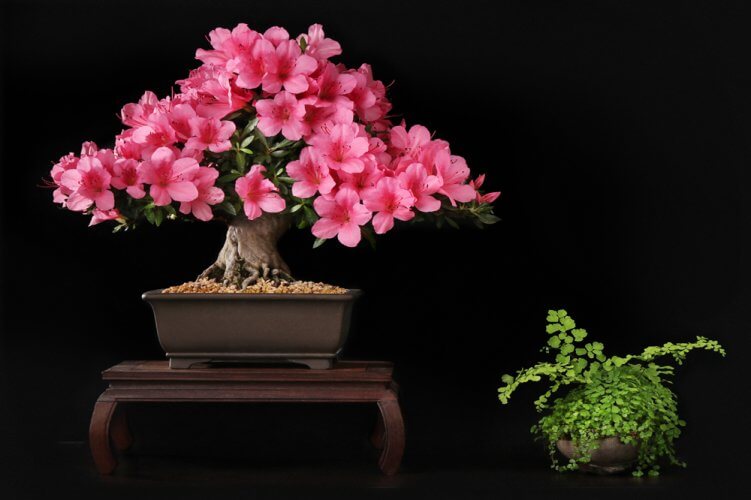Out of all the bonsai trees that do blossom, the azalea bonsai is one of the most beautiful. Much like its larger version, it is at its best during the spring when it is covered with beautiful blossoms. The Japanese Satsuki azalea (Rhododendron indicum) is the most popular variety. As the name implies, if you understand Japanese that is, it blooms in the fifth month of the year, May.

Training an Azalea Bonsai
Even when not in bloom, it’s tree-like growth habit makes it an ideal tree for training as a bonsai specimen. It has a definite trunk, allowing it to be pruned to resemble a perfect miniature tree. It is quite permissible however to allow multiple trunks to grow, and let your imagination roam free. If there is a favored shape for an azalea bonsai tree, it is probably the windswept look. Branches are usually trained as soon as the blossoms have faded and have been removed. Pruning and shaping can then be carried out as desired once the new growth appears. Additional sprouts will often appear later in the growing season, in mid-summer, and these sprouts are generally pruned back completely.
The tree version of the azalea is well suited for temperate zones and the shrub version is normally quite winter hardy. When the tree is in a container however, particularly a small one, it should be over wintered indoors to avoid a risk of freezing the root system. The azalea bonsai will be at its best when allowed to grow outside during the spring and summer months, and kept inside, best in a cooler location, in the winter.
Watering an Azalea Bonsai
Since bonsai trees are usually placed in a rather coarse soil and often in small containers, they have a tendency to dry out quickly, and something the size of a miniature azalea may have to be watered every day during the growing and blooming season, but less so during the winter months. The root system must never be allowed to dry out however, and the best way to figure out a proper watering schedule is to use the finger test, checking the moisture content of the soil by poking it with your finger, every day if need be.
Feeding an Azalea Bonsai
As far as fertilizing is concerned, the azalea tree requires feeding from the time it is starting new growth until the end of the season when growth has halted. It’s not necessary to apply fertilizer during the winter months when the tree is dormant. A balanced fertilizer, with equal parts of nitrogen, phosphorous, and potassium in either granular or liquid form, applied every couple of weeks, should suffice.
The last couple of feedings in the fall need only be on a monthly basis, and a fertilizer with less nitrogen (N) can be used, as the tree at this time is not developing new foliage.A bonsai tree is usually best watered from the bottom when it is practical to do so. If the container is small enough, it can be placed in the sink or any other container of water and allowed to soak for a few minutes. If watering from the bottom isn’t practical however it’s quite permissible to shower the tree from the top. The goal either way is to give the tree a good soaking, and then let the excess water drain away.
While not all that difficult to care for, bonsai trees do require careful and consistent attention, primarily to avoid their drying out. Just remember that a tree in a small container usually cannot be neglected for a lengthy period of time.
